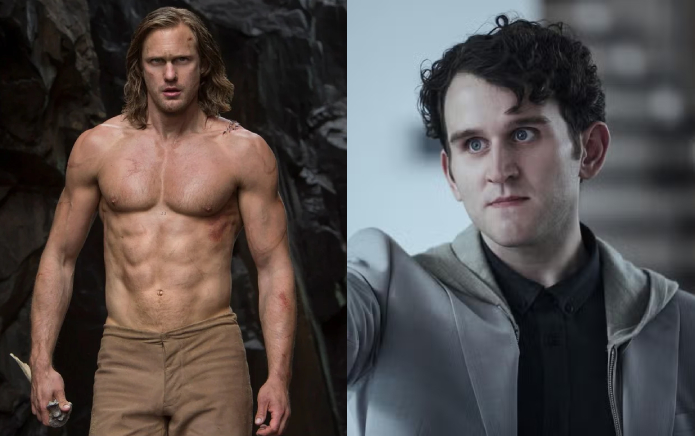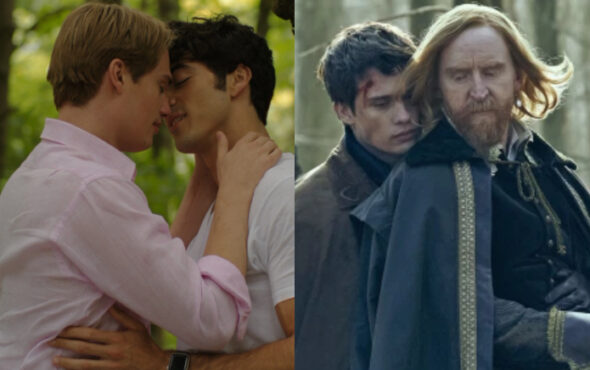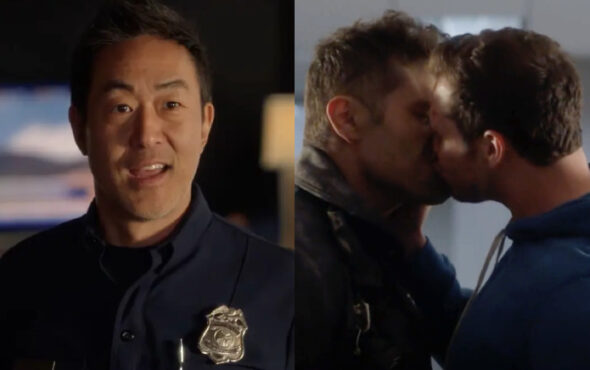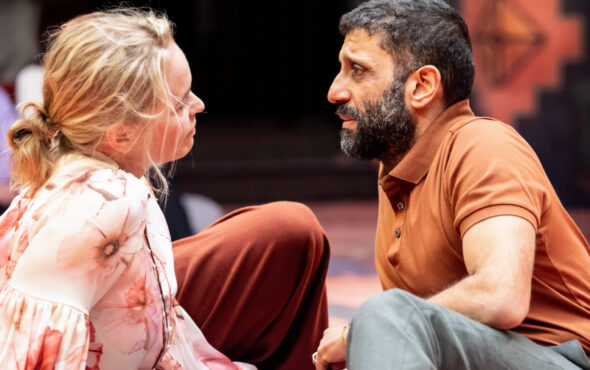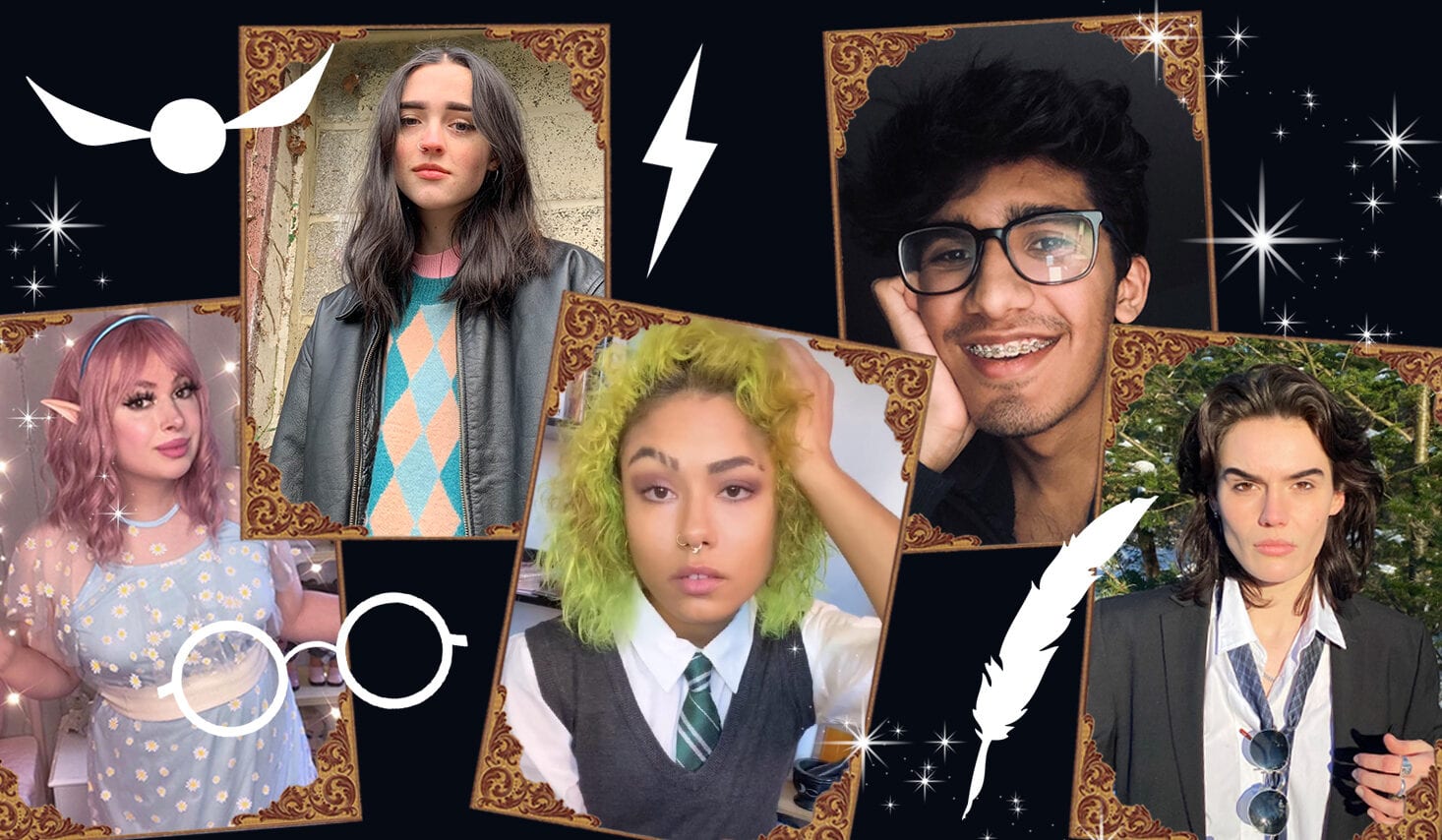
TikTok is renowned for being unpredictable. You don’t know whether you’ll get a slew of Killing Eve thirst traps or back-to-back videos of well-dressed teens lip-syncing to Billie Eilish. It’s a chaotic digital lottery that’ll always keep you guessing. So, when my haven of “do you listen to Girl In Red” memes was switched for a round of queer Harry Poter videos, you could imagine my surprise. From cosplayers, house sortings, and Hogwarts-inspired outfit trends, the allure of Hogwarts was inescapable. Packed with reimagined romance scenes and digs about a lack of diversity, LGBTQ+ fans were creatively making an online space for themselves. As the Harry Potter hype continues, GAY TIMES asked some Tik Tok creators to tells us why everyone is suddenly obsessed with witches and wizards again.
Trae Wier, 23, is no stranger to TikTok. They downloaded the app during quarantine and it wasn’t long until the creator stumbled across Harry Potter content. “At first, in the US, it was cosplayers dressing up as specific characters. Then I got a lot of queer creators making fun of the author and trying to reclaim content that they enjoyed growing up,” they tell me over Zoom. Before Trae got involved in making their own videos, they were intrigued at how different users were choosing to take control of a fictitious universe but wanted to do things differently. “I saw content creators dismantling the author’s perception of the Harry Potter world,” the recall, “But mine are more out of reclamation, so I was in my sorted house dressed in cosplay. It was to say I am here, I’m a queer person, and I’m being represented in this world.”
After thinking over the resurgence of the literary franchise, Trae considers the popularity of Harry Potter as something bigger than a fleeting trend. “I think there’s been a lot of people who related to Harry Potter and fantasy, which is to say there’s a part of myself that I can’t show to other people, or that feels different from other people, especially marginalised groups,” they explain. “I can really relate to those inserting themselves in spaces like Broadway or in small ways like TikTok creators. I think both things are successful because whether the creator of the story says its canon or not, you have now inserted your own story in theirs and what are they going to do about it?”.
While managing your own narrative is something of a right to Trae, but a pre-marriage equality world in the US, for them, felt incredibly lacking of representation in a major franchise and was a political frustration the author was able to profit off of. “By keeping her characters ambiguously queer was a marketing standpoint,” they say, nodding. “She was releasing his books pre-marriage equality, so we had very little queer representation anyway. Now with kind of like a light that has been shed on what she thinks of the queer community, at least facets of it, we know she didn’t want to have those sorts of characters in her story. Before that, she was playing both sides of the field. She could please people who didn’t want to see queer representation and give what she wanted to people who did want to see it.”
As the Harry Potter trends continue to slip in and out of popularity, the TikTok creator has been dwelling on the bigger picture of reclaiming a cultural moment outside of its original creator. “When there are words that have previously had power, do we want to dismantle the word and give another word entirely to refer to whatever we’re talking about, or do we just want to take the word and replace its meaning and reclaim it?” Trae questions. “I think that’s kind of what’s going on with people like creating their own content. Some people are creating content to break down the world, to dismantle it, and reconstruct it and to give better fantastical queer narratives to explore.
“I’m really pleased with the reclamation of the narrative, because it’s really powerful to consume this art, not knowing the background of the author and then learn it and look her metaphorically dead in the eyes and say ‘This is my story, you can’t take it away from me, and you can’t take away what it meant for me and my queerness. Whether you agree with it or not, it still has importance to me’. I wanted to give new Harry Potter fans a chance to feel belonging into a universe despite what an author says can fit into a magical world.”
Beth McAlpine, 16, found themselves drawn to TikTok after friends encouraged them to check it out. “It’s a lot of fun and it made me so much more aware of gender identity. I think everyone’s so open about stuff on there,” they tell GAY TIMES over Zoom. “I don’t know if I would have had any thoughts about whether I was non-binary or not — I never really allowed myself to think about it.” Outside of an avalanche of informative content, Beth came across DracoTok videos. The trend soon led them to make their own adapted scenes with Hermione Granger, which blew up in the UK. “I hadn’t been expecting it because it came out of nowhere and then it was like a craze here for months,” Beth says. “I thought all POVs (point of view) were kind of weird, because you’re just pretending people are there which I guess is just acting. It’s fun and if people are enjoying it, then there’s no harm in it.”
As the controversy around the franchise creator began to build, Beth felt reluctant about feeding back into a world of content that the author would benefit from, and hasn’t done it since. “When you and I spoke last, we talked about how this trend is bringing more attention to a series that was written by a transphobic awful person. If you really think about it, did we reclaim this world for queer people or if it just made it more consumable for us?” Beth reflects. “In some ways, it’s been successful, because of the feeling that queer people got from seeing queer stories in the universe that has been notoriously straight and not inclusive. For them to see that and in the world that they love. But I don’t think it’s done anything groundbreaking. I think the idea that the series is owned by the fans now is lovely, and I’d like to think that, but at the end of the day, she’s still making money from it. Any promotion or talk about that series is still benefiting a transphobe who doesn’t support our community even we are talking about a different universe where there are queer characters in it.”
The process of reclamation is a subjective one, it’s a movement, a moment even, that shifts depending on how you roll the dice. For some creators, like Beth, it’s not quite so easy to separate the art from the artist, even with a light-hearted TikTok trend. They recall seeing videos of fans creating their own reactions based on seeing Hermoine’s Yule Ball entrance. “I really liked everyone doing the Yule Ball, especially the Hermoine ones where she would walk down the stairs and they would do their reaction in awe of her. That’s how I was as a kid watching the film so I completely relate to that,” they explain. “I think it has given people the idea that they can reclaim their childhood movies and series and make it queer to fit their identities and it’s quite impactful. If people are taking it back as well, as well as making content about Harry Potter, it just shows that she doesn’t matter. Trans people should be allowed to do whatever they want with her media and just fuck her.”
Like many other creators, 17-year-old Gautam Bajaj has found TikTok to be an avenue for self-expression. His first Harry Potter video gave the suggestion of LGBTQ+ relationship which could have happened in the author wasn’t quite so problematic. We asked the teen why he thought Harry Potter TikTok was still a big hit. “It’s a wonderful world to get lost in and I think we just want to make it more inclusive, so yes, I do think that many want to reclaim it because we know that it can be better than it is and that it is a place for everyone,” he says. “A lot of the people who grew up reading [Harry Potter] are LGBTQ+, and we weren’t able to get the representation we wanted in the books, so DracoTok or LGBTQ+ Harry Potter videos is our way of saying it’s a place for everyone.”
As Gautam’s videos began to pick in likes, he found the response “inspiring” and a reminder of the “intersectionality between LGBTQ+ people and Harry Potter fans”. He elaborates: “My favourite part is the sense of community. Everyone who reads it has a different story, we all come from different places but there’s always that shared sense and love of a world that we’ve all wanted to be a part of it at one point.” Now months later after the initial explosion of Harry Potter content online, the American TikTok creator is dubious as to whether QPOC has been able to fully reclaim the fictional universe: “I feel like we still have a ways to go because, besides the occasional video like mine, most Harry Potter Videos are stuff like DracoTok,” he explains. “There’s nothing wrong with that, I just don’t think there’s enough Harry Potter content that also happens to be LGBTQ+. We’re definitely getting there, and I’m proud that we’ve gotten as far as we have.”
Melbourne-based Belle was surprised to see the fantasy franchise go full-circle again, but has been grateful for the representation it has offered as it has been especially impactful for the Australian trans youth. “A lot of kids hadn’t seen Harry Potter before and that’s why it’s kind of come around again,” she explains. ”Creators have been expanding the universe and putting themselves into the movies and roles. It’s so beautiful how, on social media, trans youth are watching us and learning to understand their identity and figure that out. It’s so important and I wish I had that when I was growing up.” Challenging that lack of trans visibility online has been online of Belle’s main goals and she is thankful for the openness on the platform. “TikTok definitely gave us a place and we ran with that – we kept pushing and making videos. I always get comments saying “Why do you have to make your whole personality being trans?” or “Why does every video have to be a trans video?’, and it’s because of this!” she laughs. “So many people didn’t understand that before and had no idea what it’s like, but now you can easily just click on the trans tags on TikTok and see all of us.”
Trans topics and representation have long been a thorny issue when it comes to the Harry Potter universe. As the new game-version of the series announces the possibility to present yourself as trans, Bellie and I talk through what its been like for a trans creator to see the debate for trans representation to play out. “I think we’ve realized the importance of putting trans characters into various roles with what she’s saying. Education has definitely been growing in the Australian community, but we still have so far to go. We still don’t teach these things to the kids in primary school and in high school. I didn’t learn anything about the LGBTQ+ community at school,” Bambi reflects. “When I post Harry Potter TikToks, it’s reaching young Australian kids and you can see the comments and some of them are confused, but as we’re getting a lot more opportunities and inclusivity, I think it will make a difference.”
As Belle’s content continues to get shared, she hopes her videos can serve as a trans-friendly space of representation online. “My best friend and I would always talk about what Hogwarts would be like for us if we were the first trans girls of Hogwarts, so it has been empowering to make these videos and not to just see it in my head, but to actually make something and to see that. When I make content, I envision myself as a younger trans kid and keep that in mind the entire time. I just think about a little trans kid watching somebody like me on TikTok.”
One day Marthe Woertman, 21, opened her app and saw DracoTok everywhere. At first, she was amused but the Dutch creator admits she “didn’t really get the hype around Draco” until she realised she could add her own twist with other characters. “I like the content and the way people created videos with actual parts of the movie and edited themselves in them. I thought that was really cool so I was like let me try that.”
Known for her glimpses into the fashion world and, now, odd character reenactments, the TikTok star reveals why she got involved in Harry Potter content. “There’s zero queer representation in the movies so that queer creators were like we’re gonna make it ourselves then, and that’s what I found fun,” she explains. “I feel like most of the age groups on TikTok have read or seen Harry Potter and when I was younger, I was a super big fan of it too.”
Marthe adds: “I always thought it was weird that there wasn’t that much LGBTQ+ representation, so I definitely think it’s a good thing that people are reclaiming it right now and putting themselves into it. After all, Harry Potter is a comfort series for such a lot of people. I made videos where I dressed up as a character and I made lesbian scenes with other Harry Potter characters. I made one with Luna Lovegood which I thought was funny, because, obviously, you don’t see that sort of thing in any of the movies, so I was like I’m gonna make it myself!”
Although DracoTok and Harry Potter TikTok videos can’t replace representation in the films or books, Marthe is convinced the social media retellings can be just as significant. “As a kid, growing up, I really missed gay representation in films. It always made me feel like I wasn’t accepted, so even in making these short videos and, even though mine are more joking, I really hope that it has a good effect on people. I hope it helps normalise queer representation a little bit,” she says. The 21-year-old even thinks the trend could come back around: “I think Harry Potter might actually stick around for a bit on TikTok. Haven’t people written fanfictions for the longest time – so isn’t this the same thing? It just feels like people are making fanfiction but in Tiktok videos, and people will always want to see that or want to create that.”
Mid-interview, the TikTok creator tries to recall her first Harry Potter post. “I made a joke about me being Snape’s daughter and hitting on one of the girls (Cho Chang). People kept telling me that I look like Snape, so I made myself Snape’s lesbian daughter and the video got a good really response,” she says. But even after her successful recreations as Snape’s or Serius Black’s queer daughter, Marthe isn’t sure she would contribute to the Harry Potter TikTok world again: “Now with the whole writing situation, I educated myself on it, and I don’t really want to do those anymore. I might do it for other shows, but not Harry Potter.”
While she might not be taking part in the TikTok trend anymore, Marthe still considers the queering of Harry Potter successful. For her, the franchise has always been closely knit to the LGBTQ+ community. “When I was 14 or 15, BuzzFeed was super popular and that’s where I got all of my queer content from. They had all of these quizzes about your house and all this Harry Potter stuff,” Marthe explains. “At that time, because of that, Harry Potter was already such a queer thing. All the gays at my school were the biggest Harry Potter fans and would always talk about what house they were in. For me, it’s always been very much associated with the gay community and I think we’ve done a pretty good job with that.”
The question of whether communities can reclaim art is one that remains to be answered. When the reputation of a creator, be it an author or a renowned musician, is stained by amoral actions or deeply offensive comments, is it possible for fans to separate the art from the artist? Franchises like Harry Potter are so deeply embedded into our cultural landscape, that no level of boycotting or shaming will constructively make a difference. But, as marginalised communities are realising, maybe it’s time for the focus to shift from the creator to the fans. As the LGBTQ+ community has proven on TikTok, there’s scope to take a bad situation and turn it into something endearing.
